Research on Risk Evolution Mechanism of Urban River Ecological Governance Project Based on Social Network Analysis
Abstract
1. Introduction
2. Research Design and Methodology
2.1. Study Design
2.2. Risk Node Identification
2.3. Network Characterization
2.3.1. Overall Network Analysis
- (1)
- Network density
- (2)
- Average path length
- (3)
- Clustering coefficient
2.3.2. Local Network
- (1)
- Degree distribution
- (2)
- Medio centricity
- (3)
- Proximity centrality
- (4)
- PR value
- (5)
- Eigenvector centrality
3. Construction of Risk Network
3.1. Risk Element Relationship Extraction
- (1)
- Formation of a senior expert group
- (2)
- Conducting expert consultation activities
3.2. Construction of Complex Network Model
4. Case Study: Application in Jinghe River Management
4.1. Mapping of Risk Network
4.2. Risk Network Parameter Analysis
4.2.1. Analysis of Overall Network Parameters
- (1)
- Network density
- (2)
- Clustering coefficient
- (3)
- Average path length
- (4)
- Cohesive analysis
4.2.2. Network Local Parameter Analysis
- (1)
- Degree and degree distribution
- (2)
- Proximity to the center
- (3)
- Intermediation centrality
- (4)
- Eigenvector centrality
- (5)
- PR value
4.2.3. Critical Risk Determination
5. Discussion
6. Conclusions
Author Contributions
Funding
Data Availability Statement
Conflicts of Interest
References
- Wang, S.; Wu, J.; Wang, S.; Xie, X.; Fan, Y.; Lv, L.; Huang, G. Copula-based multivariate simulation approach for flood risk transfer of multi-reservoirs in the Weihe River, China. Water 2022, 14, 2676. [Google Scholar] [CrossRef]
- Pashayan, N.; Antoniou, A.C.; Lee, A.N.; Wolfson, M.; Chiquette, J.; Eloy, L.; Eisen, A.; Stockley, T.L.; Nabi, H.; Brooks, J.D.; et al. Should age-dependent absolute risk thresholds be used for risk stratification in risk-stratified breast cancer screening? J. Pers. Med. 2021, 11, 916. [Google Scholar] [CrossRef]
- Ma, C.; Yang, J.; Zenz, G.; Staudacher, E.J.; Cheng, L. Calibration of the microparameters of the discrete element method using a relevance vector machine and its application to rockfill materials. Adv. Eng. Softw. 2020, 147, 102833. [Google Scholar] [CrossRef]
- Ma, C.H.; Yang, J.; Cheng, L.; Ran, L. Research on slope reliability analysis using multi-kernel relevance vector machine and advanced first-order second-moment method. Eng. Comput. 2021, 38, 3057–3068. [Google Scholar] [CrossRef]
- Wang, A.; Gao, X.D. A variable scale case-based reasoning method for evidence location in digital forensics. Future Gener. Comput. Syst. 2021, 122, 209–219. [Google Scholar] [CrossRef]
- Kaleh, H.; Mohammadian, F.; Pouyakian, M. Developing a safety audit checklist for in-operation administrative buildings. Work 2021, 70, 785–794. [Google Scholar] [CrossRef]
- Zhang, W.P.; Li, B.; Liu, Z.J.; Zhang, B.B. Application of improved fuzzy comprehensive evaluation method in karst groundwater quality evaluation: A case study of Cengong county. Earth Sci. Inform. 2021, 14, 1101–1109. [Google Scholar] [CrossRef]
- Ahn, Y.J.; Yu, Y.U.; Kim, J.K. Accident cause factor of fires and explosions in tankers using fault tree analysis. J. Mar. Sci. Eng. 2021, 9, 844. [Google Scholar] [CrossRef]
- Cheng, Y.; Wang, Z.Z.; Xu, C.D.; Cheng, H.; Zhu, X.L. Safety grade evaluation of aqueduct structure based on fuzzy cloud theory analysis. Teh. Vjesn.—Tech. Gaz. 2020, 27, 874–882. [Google Scholar] [CrossRef]
- Kang, J.F.; Dong, E.C.; Li, X.D.; Guo, Z.; Shi, L.; Li, D.C.; Wang, L. Topological design and biomechanical evaluation for 3D printed multi-segment artificial vertebral implants. Mater. Sci. Eng. C—Mater. Biol. Appl. 2021, 127, 112250. [Google Scholar] [CrossRef]
- Wei, X.; Shiwei, H.; Zhaohui, L.; Yidong, W.; Mengyao, W.; Weiwen, M. Construction and analysis of railway accident causal network based on association rules. Railw. Transp. Econ. 2020, 42, 72–79. [Google Scholar] [CrossRef]
- Lingling, H.; Wei, Z. Analysis of railway accident causes based on complex network theory. Chin. J. Saf. Sci. 2019, 29, 114–119. [Google Scholar] [CrossRef]
- Xin, M. Risk assessment of railway dangerous goods transportation based on complex network and fuzzy analytic hierarchy process. Transp. Technol. Econ. 2018, 20, 29–33+39. [Google Scholar] [CrossRef]
- Qin, X.; Fan, L. Evolution of safety risks for amphibious seaplane takeoff and landing based on complex networks. Complex Syst. Complex. Sci. 2019, 16, 19–30. [Google Scholar] [CrossRef]
- Wenheng, L. Analysis of Traffic Accident Characteristics and Accident Cause Depth in Road Sections Passing through Villages and Towns. Master’s Thesis, Beijing Jiaotong University, Beijing, China, 2018. [Google Scholar]
- Xiangkun, M.; Guoming, C.; Hongwei, Z. Complex network analysis of submarine pipeline leakage risk evolution. China’s Saf. Prod. Sci. Technol. 2017, 13, 26–31. [Google Scholar] [CrossRef]
- Xiaopeng, L.; Cunbin, L.; Ding, L.; Xiaokun, S. Analysis of power CPS accident modeling based on DEMATEL-ISM. J. North China Electr. Power Univ. Nat. Sci. Ed. 2018, 45, 67–77. [Google Scholar]
- Jing, Y.; Tongzhou, Z. Research on the importance of nodes in complex social networks. Comput. Digit. Eng. 2016, 44, 80–82+87. [Google Scholar] [CrossRef]
- Jingchun, S.; Chenyu, W. Research on simulation of corporate advertising strategies based on complex social networks. Calculate 2021, 40, 62–68. [Google Scholar]
- Haoran, Y.; Sipeng, H. Research on the diffusion of power substitution technology in terminal enterprise clusters based on complex network evolutionary game theory. Power Supply Consum. 2022, 39, 48–53+60. [Google Scholar] [CrossRef]
- Williams, R.J.; Berlow, E.L.; Dunne, J.A.; Barabasi, A.-L.; Martinez, N.D. Two degrees of separation in complex food webs. Proc. Natl. Acad. Sci. USA 2002, 99, 12913–12916. [Google Scholar] [CrossRef]
- Montoya, J.M.; Sol, R.V. Small world patterns in food webs. J. Theor. Biol. 2002, 214, 405–412. [Google Scholar] [CrossRef] [PubMed]
- Camacho, J.; Guimera, R.; Nunes Amaral, L.A. Robust patterns in food web structure. Phys. Rev. Lett. 2002, 88, 228102. [Google Scholar] [CrossRef]
- Jeong, H.; Tombor, B.; Albert, R.; Oltvai, Z.N.; Barabasi, A.L. The large-scale organization of metabolic networks. Nature 2000, 407, 651–654. [Google Scholar] [CrossRef] [PubMed]
- Fell, D.A.; Wagner, A. The small world of metabolism. Nat. Biotechnol. 2000, 18, 1121–1122. [Google Scholar] [CrossRef] [PubMed]
- Jingfeng, Y.; Qiming, L.; Ruoyu, J.; Zhiru, W. Vulnerability analysis of urban metro network system operation. Chin. J. Saf. Sci. 2012, 22, 92–98. [Google Scholar] [CrossRef]
- Dachen, L.; Xingpei, J.; Bo, W.; Fei, T. Topological vulnerability analysis and countermeasures of electric power communication network based on complex network theory. Power Grid Technol. 2015, 39, 3615–3621. [Google Scholar] [CrossRef]
- Qinglin, Z. Study on risk decision model of water conservancy engineering bid evaluation based on life cycle theory. Water Conserv. Plan. Des. 2019, 01, 80–83. [Google Scholar] [CrossRef]
- Ziye, Y.; Yakun, Z.; Zekun, W.; Wenzhe, T. A partnership based water conservancy project construction management model: A case study of ningxia water conservancy project. J. Hydropower 2022, 41, 35–41. [Google Scholar]
- Chunsheng, C.; Ting, Z.; Yunge, L.; Xiaoning, X.; Wenjie, Z. Study on risk assessment of large water conservancy project based on entropy weighted matter element. Pract. Underst. Math. 2021, 51, 47–55. [Google Scholar]
- Wei, G.; Dingbin, L.; Xichen, Z.; Ji, L.; Jianyou, W.; Fengyao, Z. Atastrophe evaluation method for evaluating the risk of land acquisition and resettlement in large linear projects. Yellow River 2019, 41, 119–121+130. [Google Scholar] [CrossRef]
- Xin, J.; Xuelian, L.; Jinghan, W.; Wei, L.; Dongli, L.; Fan, F. SD model for social stability risk evolution of sensitive water conservancy projects. Chin. J. Saf. Sci. 2021, 31, 18–26. [Google Scholar] [CrossRef]
- Qixiang, F.; Peng, L.; Pengcheng, W.; Zhilin, W.; Xianrong, L.; Jianye, Y. Occurrence Mechanism and Management Countermeasures of Safety Accidents in Hydropower Projects. Chin. J. Saf. Sci. 2019, 29, 144–149. [Google Scholar] [CrossRef]
- Hongyan, Z.; Peng, G. Risk analysis and countermeasures for safety management of water conservancy and hydropower projects. China’s Saf. Prod. Sci. Technol. 2017, 13, 89–92. [Google Scholar]
- Li, Z. Risk assessment of long span bridge project based on fuzzy comprehensive theory. Highw. Transp. Technol. Appl. Technol. Ed. 2011, 7, 270–272. [Google Scholar]
- Xuan, Q.; Lei, J. Assessment and analysis of life cycle risk factors for green buildings: A questionnaire-based exploration. J. Civ. Eng. 2013, 46, 123–135. [Google Scholar] [CrossRef]
- Guixiang, C.; Hongwei, H.; Jianxin, Y. Research on life cycle risk management of metro projects. J. Undergr. Space Eng. 2006, 01, 47–51. [Google Scholar]
- Yunli, G.; Hongnan, L.; Guojun, Z. Dynamic fuzzy evaluation of engineering project risk based on cooperation. J. Dalian Univ. Technol. 2010, 50, 404–408. [Google Scholar]
- Jiwei, F.; Kaichang, S.; Xin, Y. Human risk analysis of hydraulic engineering based on complex network theory. People’s Yangtze River 2022, 53, 155–159. [Google Scholar] [CrossRef]
- Changsheng, L.; Wenzhe, T.; Tengfei, W. Risk management of water conservancy project: Taking Ningxia Water Conservancy Project as an example. J. Tsinghua Univ. Nat. Sci. Ed. 2023, 63, 233–241. [Google Scholar] [CrossRef]
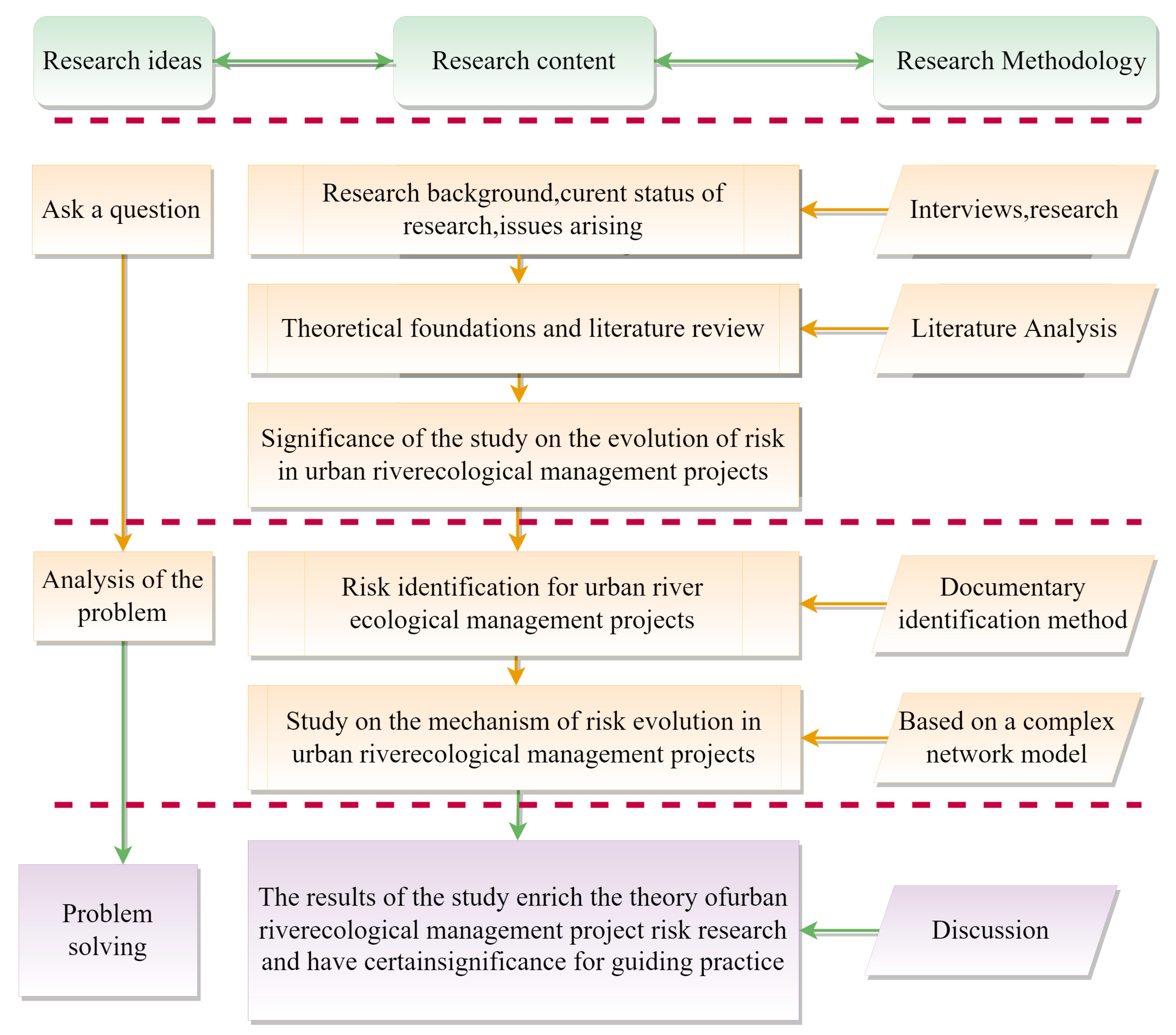
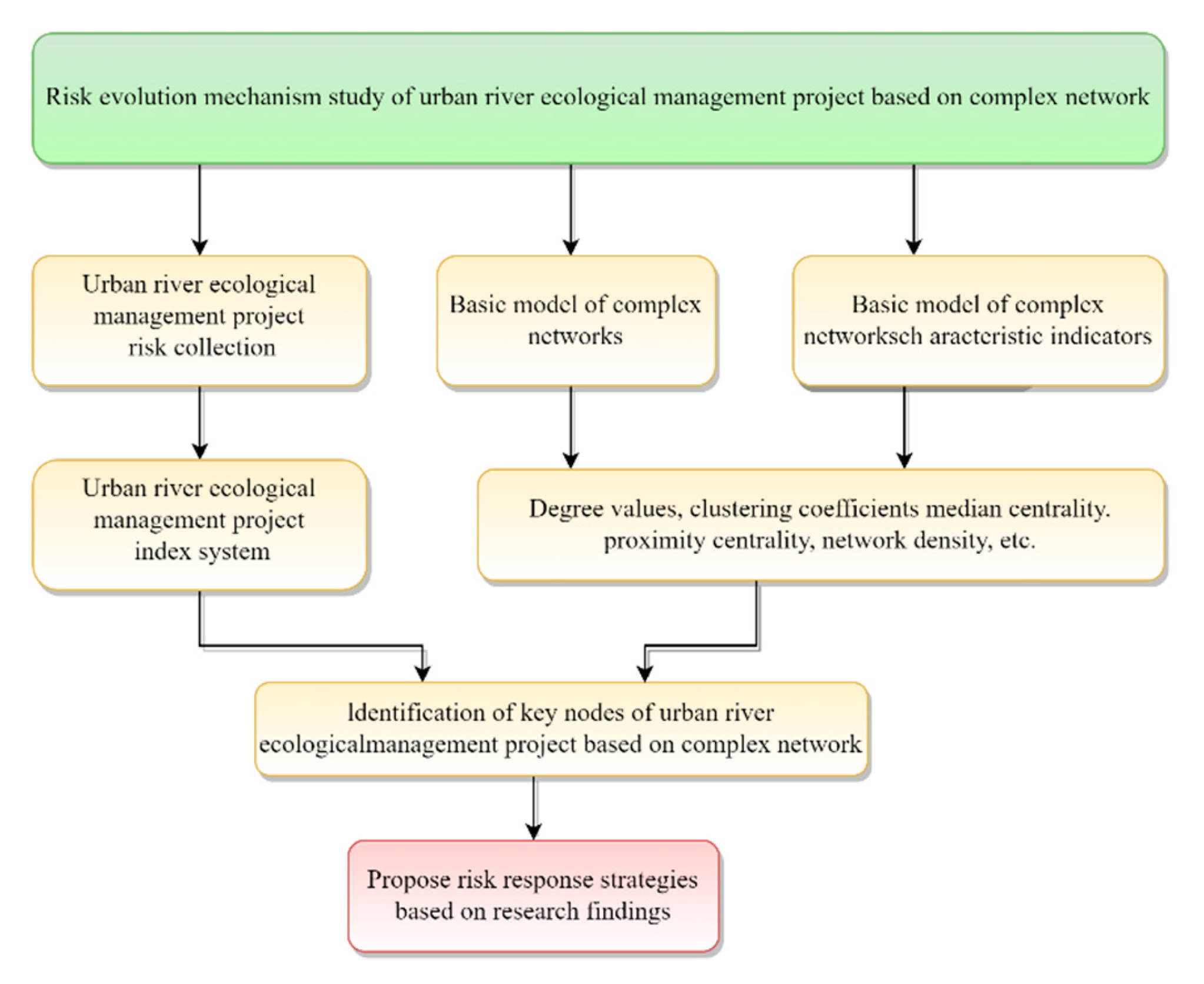
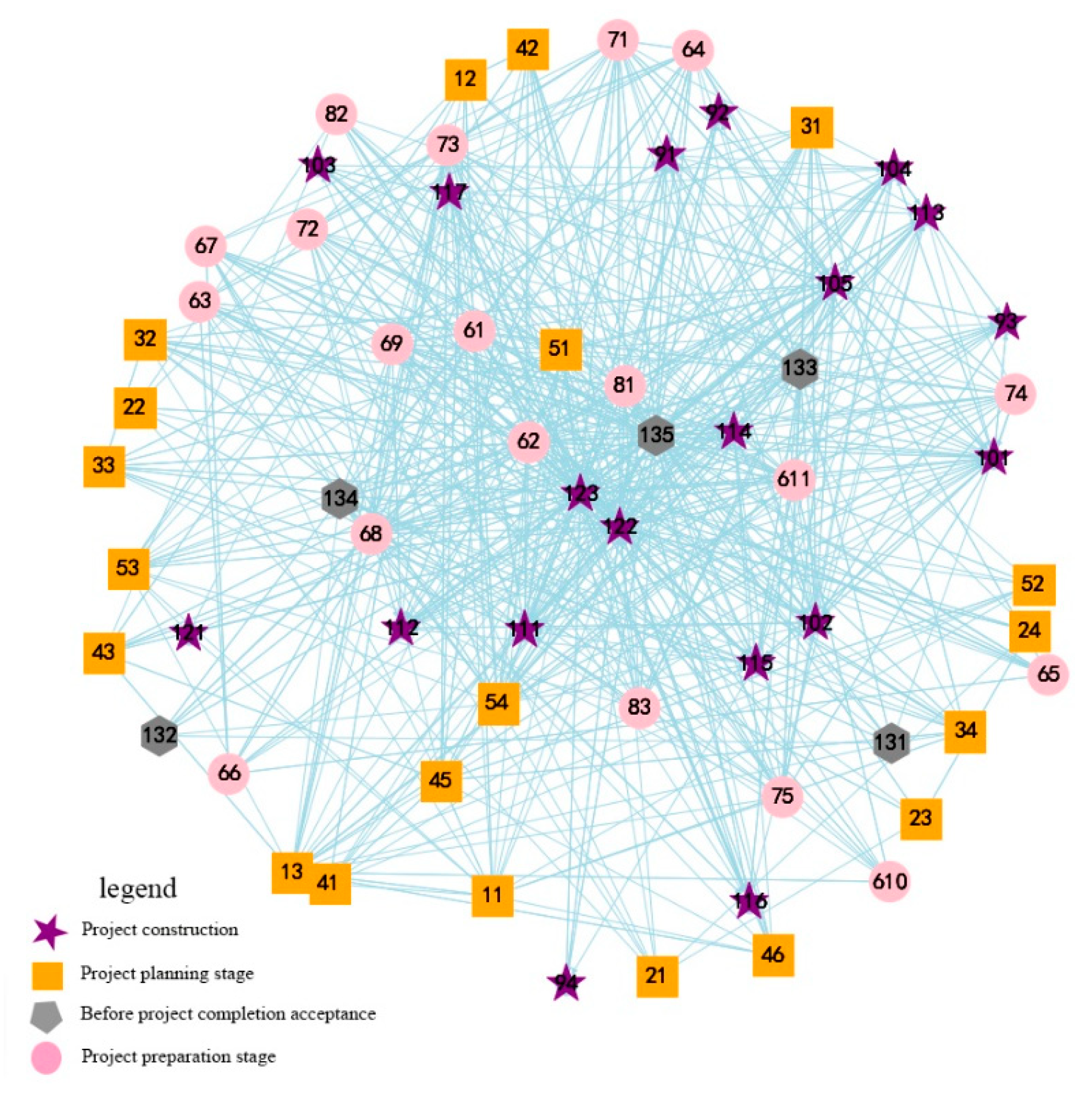
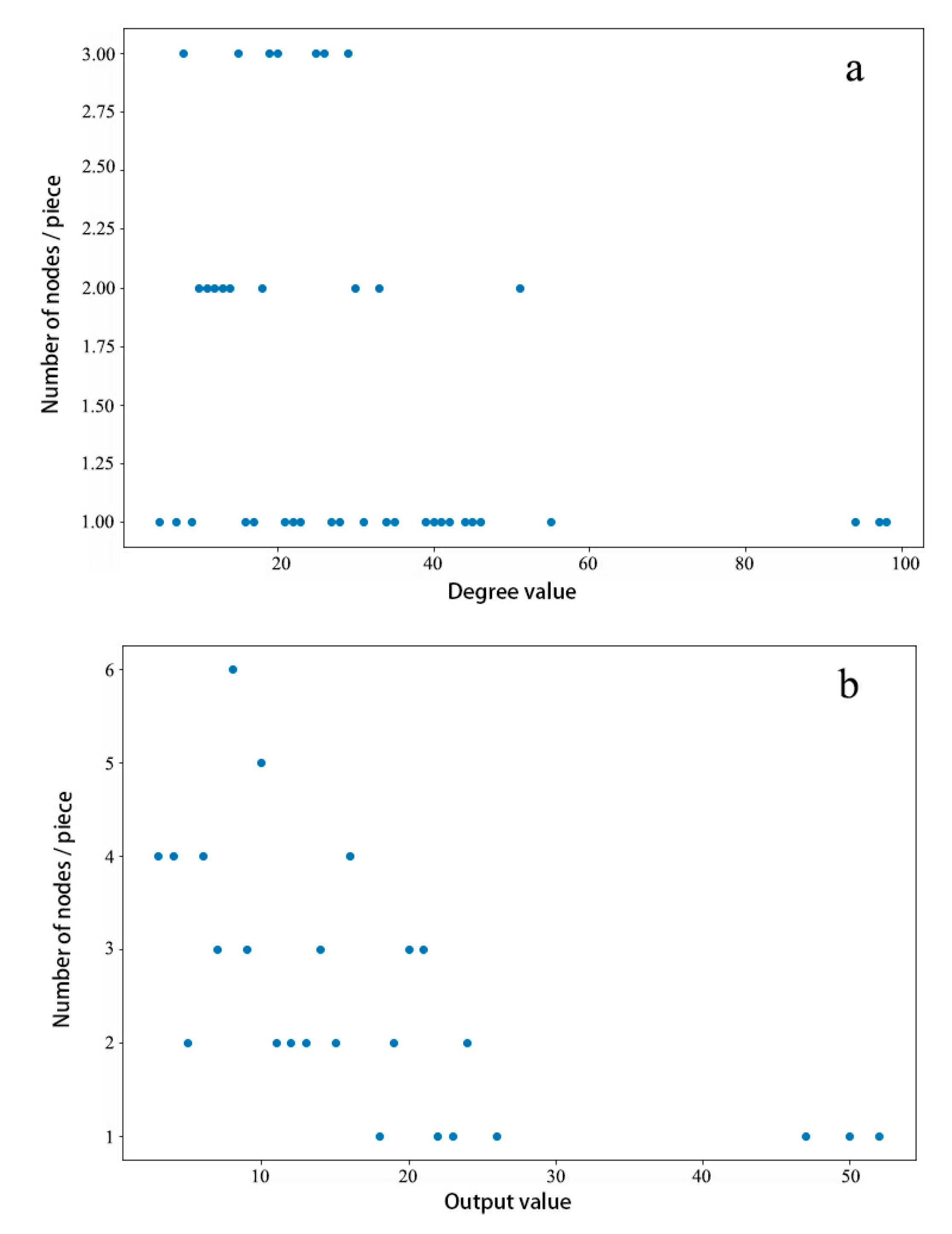
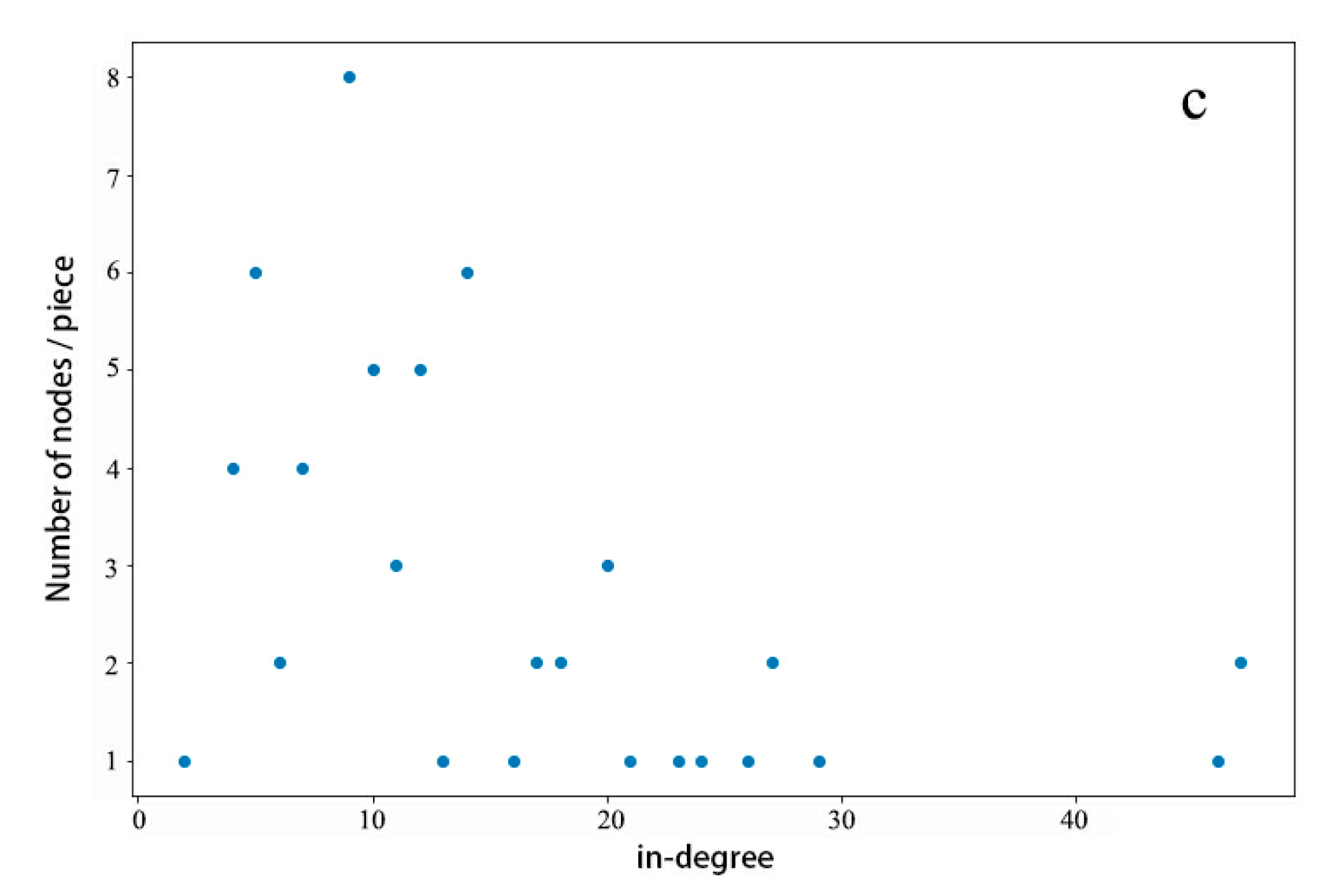
| Stage | Level 1 Risk | Level 2 Risk |
|---|---|---|
| project plan | 1 Political risks | 11 Project Approval Risks |
| 12 Government credit risk | ||
| 13 Legal and regulatory risks | ||
| 2 Economic risks | 21 Funded risk | |
| 22 Inflation risk | ||
| 23 Interest rate change risk | ||
| 24 Financing risk | ||
| 3 Natural environment risks | 31 Hydrological and geological risks | |
| 32 Meteorological condition risk | ||
| 33 Natural force majeure risk | ||
| 34 Ecological environment risk | ||
| 4 Social risks | 41 Social and cultural risks | |
| 42 Resident negotiate land acquisition risk | ||
| 43 Social security risk | ||
| 45 Public opinion risk | ||
| 46 Land change risk | ||
| 5 Project decision risks | 51 Risk of basic acceptance before implementation | |
| 52 Decision error risk | ||
| 53 Approval of work procedure compliance risk | ||
| 54 Incomplete collection of basic data risk | ||
| Project standard Preparation stage | 6 Bidding risks | 61 Bidder technical and management risk |
| 62 Project complexity risk | ||
| 63 Competitive risk | ||
| 64 Bid evaluation risk | ||
| 65 Calibration risk | ||
| 66 Risk of information leakage | ||
| 67 Risk of bidding documents | ||
| 68 Contract perfection risk | ||
| 69 Risk of contract signing deviating from bidding content | ||
| 610 Legality risk of contract signing procedure | ||
| 611 Contract dispute risk | ||
| 7 Planning and design risks | 71 Qualification risk of design unit | |
| 72 Design progress lag risk | ||
| 73 Design has defects, errors, omissions and frequent changes | ||
| 74 Improper standard selection | ||
| 75 Survey accuracy risk | ||
| 8 Preparation before construction risks | 81 Construction site layout and technical preparation risk | |
| 82 Risk of insufficient supply of substances (materials) and materials | ||
| 83 Risk of illegal commencement | ||
| Project construction stage | 9 Construction personnel risks | 91 Low technical level |
| 92 Weak safety awareness | ||
| 93 Qualification risk of employees | ||
| 94 Risk of slowdown of construction personnel | ||
| 10 Construction technology risks | 101 Risk of improper drawing design | |
| 102 Engineering technology risk | ||
| 103 Risk of construction equipment | ||
| 104 Risk of cross operation | ||
| 105 Construction accident risk | ||
| 11 Construction management risks | 111 Safety management risk | |
| 112 Coordination risks of participants | ||
| 113 Rationality of construction organization design | ||
| 114 Plan adjustment and engineering change | ||
| 115 Contract management and execution risk | ||
| 116 The organizational structure setting is chaotic | ||
| 117 Management authority risk | ||
| 12 Risk factors of construction period | 121 Certificate cycle | |
| 122 Construction period | ||
| 123 Risk of construction delay | ||
| Project completion acceptance stage | 13 Quality assessment risk | 131 Risk of unqualified project acceptance and putting into use |
| 132 Risk of file transfer not in place | ||
| 133 Quality assessment risk | ||
| 134 Audit risk | ||
| 135 Cost overrun |
| Risk Factor | A1 | A2 | A3 | … | An |
|---|---|---|---|---|---|
| A1 | 0 | b12 | b13 | … | b1n |
| A2 | b21 | 0 | b23 | … | b2n |
| A3 | b31 | b32 | 0 | … | b3n |
| ︙ | ︙ | ︙ | ︙ | 0 | b4n |
| An | bn1 | bn2 | bn3 | bn4 | 0 |
| Clique | Risk Name | Size | Cohesion Index |
|---|---|---|---|
| Clique74 | 122, 123, 135, 66, 61, 63, 64, 65 | 8 | 2.558 |
| Clique50 | 122, 123, 135, 32, 31, 33, 75, 105, 114 | 9 | 2.418 |
| Clique49 | 122, 123, 135, 32, 31, 33, 75, 105, 111 | 9 | 2.371 |
| Clique4 | 122, 123, 135,62, 10, 101, 114, 611, 112, 113, 115 | 11 | 2.335 |
| Clique51 | 122, 123, 135, 32, 31, 33, 34 | 7 | 2.333 |
| G-Clique | Risk Name | Size | Density |
|---|---|---|---|
| G-Clique23 | 72, 73, 54, 114, 115, 62, 122, 123, 101, 102, 611, 135 | 12 | 0.985 |
| G-Clique24 | 72, 113, 54, 114, 115, 62, 122, 123, 101, 102, 611, 135 | 12 | 0.985 |
| G-Clique26 | 112, 113, 54, 114, 115, 62, 122, 123, 101, 102, 611, 135 | 12 | 0.985 |
| Node Number | The Degree of Input | The Degree of Output | Degree | Node Number | The Degree of Input | The Degree of Output | Degree |
|---|---|---|---|---|---|---|---|
| 11 | 12 | 8 | 20 | 105 | 27 | 24 | 51 |
| 12 | 7 | 7 | 14 | 81 | 12 | 13 | 25 |
| 13 | 17 | 12 | 29 | 111 | 26 | 19 | 45 |
| 31 | 14 | 9 | 23 | 41 | 7 | 3 | 10 |
| 32 | 12 | 7 | 19 | 72 | 12 | 14 | 26 |
| 34 | 9 | 10 | 19 | 101 | 24 | 20 | 44 |
| 45 | 9 | 16 | 25 | 114 | 18 | 22 | 40 |
| 73 | 18 | 16 | 34 | 134 | 10 | 20 | 30 |
| 75 | 14 | 12 | 26 | 54 | 20 | 19 | 39 |
| 24 | 5 | 4 | 9 | 71 | 20 | 15 | 35 |
| 42 | 9 | 9 | 18 | 83 | 9 | 13 | 22 |
| 52 | 5 | 5 | 10 | 93 | 10 | 10 | 20 |
| 53 | 11 | 8 | 19 | 103 | 9 | 6 | 15 |
| 43 | 7 | 8 | 15 | 131 | 4 | 8 | 12 |
| 46 | 5 | 8 | 13 | 132 | 5 | 6 | 11 |
| 51 | 10 | 21 | 31 | 61 | 14 | 16 | 30 |
| 68 | 20 | 21 | 41 | 62 | 29 | 26 | 55 |
| 69 | 23 | 23 | 46 | 67 | 11 | 10 | 21 |
| 610 | 6 | 6 | 12 | 113 | 14 | 14 | 28 |
| 611 | 13 | 20 | 33 | 115 | 17 | 16 | 33 |
| 74 | 14 | 11 | 25 | 133 | 27 | 24 | 51 |
| 21 | 5 | 3 | 8 | 64 | 14 | 15 | 29 |
| 22 | 4 | 4 | 8 | 65 | 9 | 6 | 15 |
| 23 | 4 | 4 | 8 | 66 | 5 | 9 | 14 |
| 82 | 9 | 4 | 13 | 104 | 11 | 18 | 29 |
| 135 | 47 | 47 | 94 | 112 | 16 | 11 | 27 |
| 63 | 10 | 10 | 20 | 116 | 9 | 7 | 16 |
| 122 | 47 | 50 | 97 | 117 | 7 | 10 | 17 |
| 123 | 46 | 52 | 98 | 92 | 6 | 5 | 11 |
| 33 | 10 | 8 | 18 | 94 | 4 | 3 | 7 |
| 91 | 12 | 14 | 26 | 121 | 2 | 3 | 5 |
| 102 | 21 | 21 | 42 |
| Ranking | Risk Name | Near Centrality | Risk Name | Intermediary Centrality | Risk Name | Centrality of Eigenvector | Risk Name | Clustering Coefficient | Risk Name | Pagerank |
|---|---|---|---|---|---|---|---|---|---|---|
| 1 | 135 | 0.81 | 135 | 698.31 | 122 | 0.29 | 95 | 1.00 | 135 | 0.05 |
| 2 | 122 | 0.81 | 132 | 600.86 | 132 | 0.29 | 92 | 0.88 | 122 | 0.05 |
| 3 | 132 | 0.79 | 122 | 557.77 | 135 | 0.28 | 33 | 0.82 | 132 | 0.05 |
| 4 | 62 | 0.63 | 62 | 146.86 | 105 | 0.22 | 32 | 0.77 | 105 | 0.03 |
| 5 | 105 | 0.62 | 133 | 115.06 | 62 | 0.22 | 117 | 0.76 | 62 | 0.03 |
| 6 | 111 | 0.62 | 69 | 82.86 | 111 | 0.21 | 93 | 0.75 | 111 | 0.03 |
| 7 | 133 | 0.61 | 13 | 77.95 | 101 | 0.20 | 64 | 0.74 | 133 | 0.03 |
| 8 | 101 | 0.61 | 73 | 73.66 | 102 | 0.18 | 82 | 0.73 | 101 | 0.02 |
| 9 | 69 | 0.60 | 105 | 67.54 | 133 | 0.18 | 112 | 0.72 | 102 | 0.02 |
| 10 | 71 | 0.59 | 45 | 63.70 | 69 | 0.17 | 91 | 0.71 | 69 | 0.02 |
| Serial Number | Degree | Near Centrality | Feature Vector | PageRank |
|---|---|---|---|---|
| 1 | 132 | 135 | 122 | 135 |
| 2 | 122 | 122 | 132 | 122 |
| 3 | 135 | 132 | 135 | 132 |
| 4 | 62 | 62 | 105 | 105 |
| 5 | 133 | 105 | 62 | 62 |
| 6 | 105 | 111 | 111 | 111 |
| 7 | 72 | 133 | 101 | 133 |
| 8 | 111 | 101 | 102 | 101 |
| 9 | 101 | 69 | 133 | 102 |
| 10 | 102 | 71 | 69 | 69 |
| Node Type | Node | Risk Name | Production Stage | Judgment Basis |
|---|---|---|---|---|
| Initial risk node | 132 | Risk of construction delay | Project construction stage | Ranking first in terms of exit, third in terms of entry and first in terms of value |
| 122 | Construction period risk | Project construction stage | The output ranked second, the entry ranked first and the value ranked second | |
| 135 | Cost overrun risk | Project completion acceptance stage | The output ranks third, the input ranks second and the value ranks third | |
| Conduction risk node | 62 | Project complexity risk | Project preparation stage | The output ranks fourth, the PR value ranks top (fifth), the feature vector (fifth) and the intermediary centrality (fourth) |
| 133 | Quality assessment risk | Project completion acceptance stage | The ranking of degree value, PR value (seventh), intermediary centrality (fifth) and proximity centrality (seventh) | |
| 105 | Construction accident risk | Project construction stage | The ranking of degree value is high (sixth), PR is high (fourth), intermediary centrality is high (ninth) and close to centrality (fifth) | |
| 111 | Safety management risk | Project construction stage | The ranking of degree value is high (eighth), the ranking of PR value is high (sixth), the ranking of intermediary centrality is high (fifth) and close to centrality (seventh)) | |
| 101 | Risk of improper drawing design | Project construction stage | The degree value ranks first (ninth), the PR value ranks first (seventh), the centrality of the eigenvector ranks first (seventh) and the near centrality ranks eighth | |
| 69 | Risk of contract signing deviating from bidding content | Project preparation stage | The output value ranks high, the PR value ranks high (tenth), the intermediary centrality ranks high (sixth) and the feature vector centrality ranks high |
Disclaimer/Publisher’s Note: The statements, opinions and data contained in all publications are solely those of the individual author(s) and contributor(s) and not of MDPI and/or the editor(s). MDPI and/or the editor(s) disclaim responsibility for any injury to people or property resulting from any ideas, methods, instructions or products referred to in the content. |
© 2023 by the authors. Licensee MDPI, Basel, Switzerland. This article is an open access article distributed under the terms and conditions of the Creative Commons Attribution (CC BY) license (https://creativecommons.org/licenses/by/4.0/).
Share and Cite
Xu, J.; Zhu, J.; Xie, J. Research on Risk Evolution Mechanism of Urban River Ecological Governance Project Based on Social Network Analysis. Water 2023, 15, 2012. https://doi.org/10.3390/w15112012
Xu J, Zhu J, Xie J. Research on Risk Evolution Mechanism of Urban River Ecological Governance Project Based on Social Network Analysis. Water. 2023; 15(11):2012. https://doi.org/10.3390/w15112012
Chicago/Turabian StyleXu, Junke, Jiwei Zhu, and Jiancang Xie. 2023. "Research on Risk Evolution Mechanism of Urban River Ecological Governance Project Based on Social Network Analysis" Water 15, no. 11: 2012. https://doi.org/10.3390/w15112012
APA StyleXu, J., Zhu, J., & Xie, J. (2023). Research on Risk Evolution Mechanism of Urban River Ecological Governance Project Based on Social Network Analysis. Water, 15(11), 2012. https://doi.org/10.3390/w15112012





